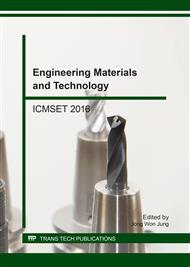[1]
S. Iijima, Helical microtubules of graphitic carbon, Nature, 354(6348) (1991) 56-58.
DOI: 10.1038/354056a0
Google Scholar
[2]
Sami-Ullah, S., Waqar, S. M. H., Hussain, F., & Ali, A, Synthesis of Single and Multi Walled Carbon Nanotubes by Improved Arc Discharge Method, Key Engineering Materials. 510(2012) 124-131. Trans Tech Publications.
DOI: 10.4028/www.scientific.net/kem.510-511.124
Google Scholar
[3]
Arora, Neha, and N. N. Sharma, Arc discharge synthesis of carbon nanotubes: Comprehensive review, Diamond and Related Materials 50 (2014) 135-150.
DOI: 10.1016/j.diamond.2014.10.001
Google Scholar
[4]
E. I. Waldorff, A. M. Waas, P. P. Friedmann, M. Keidar, Characterization of carbon nanotubes produced by arc discharge: Effect of the background pressure, J. Appl. Phys. 95(5) (2004) 2749-2754.
DOI: 10.1063/1.1642737
Google Scholar
[5]
S. P. Doherty, R. P. H. Chang, Synthesis of multiwalled carbon nanotubes from carbon black, Appl. Phys. Lett. 81(13) (2002) 2466-2468.
DOI: 10.1063/1.1509470
Google Scholar
[6]
S. Kishinevsky, S. I. Nikitenko, D. M. Pickup, E. R. van-Eck, A. Gedanken, Catalytic transformation of carbon black to carbon nanotubes, Chem. Mater. 14(11) (2002) 4498-4501.
DOI: 10.1021/cm025598j
Google Scholar
[7]
D. B. Buchholz, S. P. Doherty, R. P. H. Chang, Mechanism for the growth of multiwalled carbon-nanotubes from carbon black, Carbon, 41(8) (2003) 1625-1634.
DOI: 10.1016/s0008-6223(03)00110-6
Google Scholar
[8]
H. Lange, M. Bystrzejewski, A. Huczko, Influence of carbon structure on carbon nanotube formation and carbon arc plasma, Diam. Relat. Mater. 15(4) (2006) 1113-1116.
DOI: 10.1016/j.diamond.2005.11.026
Google Scholar
[9]
Z. G. Chen, F. Li, W. C. Ren, H. Cong, C. Liu, G. Q. Lu, H. M. Cheng, Double-walled carbon nanotubes synthesized using carbon black as the dot carbon source, Nanotech. 17(13) (2006) 3100.
DOI: 10.1088/0957-4484/17/13/003
Google Scholar
[10]
J. B. Donnet, H. Oulanti, T. Le Huu, Mechanism growth of multiwalled carbon nanotubes on carbon black, Diam. Relat. Mater. 17(7) (2008) 1506-1512.
DOI: 10.1016/j.diamond.2008.01.001
Google Scholar
[11]
A. Hekmat-Ardakan, Y. Alinejad, A. Shahverdi, G. Soucy, Experimental and thermochemical evaluation of induction thermal plasma grown single-walled carbon nanotube synthesized by commercial carbon blacks with different sulfur content, Thermochimica Acta. 565 (2013).
DOI: 10.1016/j.tca.2013.04.035
Google Scholar
[12]
V. Asokan, D. Velauthapillai, R. Løvlie, D. N. Madsen, Effect of substrate and catalyst on the transformation of carbon black into nanotubes, J. Mater. Sci.: Mater. Electron. 24(9) (2013) 1-9.
DOI: 10.1007/s10854-013-1233-z
Google Scholar
[13]
V. Asokan, D. Madsen, D. Velauthapillai, V. Myrseth, P. Kosinski, Effect of Temperature on the Transformation of Carbon Black into Nanotubes, Advanced Materials Research. 875-877(2014) 1565-1571.
DOI: 10.4028/www.scientific.net/amr.875-877.1565
Google Scholar
[14]
Arora, Neha, and N. N. Sharma, Sustained arc temperature: better marker for phase transformation of carbon black to multiwalled carbon nanotubes in arc discharge method, Materials Research Express. 3(10) (2016) 105030.
DOI: 10.1088/2053-1591/3/10/105030
Google Scholar
[15]
T. Sugai, H. Omote, S. Bandow, N. Tanaka, H. Shinohara, Production of fullerenes and single-wall carbon nanotubes by high-temperature pulsed arc discharge, J. Chem. Phys. 112 (2000) 6000.
DOI: 10.1063/1.481172
Google Scholar
[16]
T. Sugai, H. Yoshida, T. Shimada, T. Okazaki, H. Shinohara, S. Bandow, New synthesis of high-quality double-walled carbon nanotubes by high-temperature pulsed arc discharge, Nano Lett. 3(6) (2003) 769-773.
DOI: 10.1021/nl034183+
Google Scholar
[17]
N. Parkansky, R. L. Boxman, B. Alterkop, I. Zontag, Y. Lereah, Z. Barkay, Single-pulse arc production of carbon nanotubes in ambient air, J. Phys. D: Appl. Phys. 37(19) (2004) 2715.
DOI: 10.1088/0022-3727/37/19/015
Google Scholar
[18]
Y. Y. Tsai, J. S. Su, C. Y. Su, A novel method to produce carbon nanotubes using EDM process, Int. J. Mach. Tools Manuf. 48(15) (2008) 1653-1657.
DOI: 10.1016/j.ijmachtools.2008.07.005
Google Scholar
[19]
K. K. Kia, F. Bonabi, Electric field induced needle-pulsed arc discharge carbon nanotube production apparatus: Circuitry and mechanical design, Rev. Sci. Instrum. 83(12) (2012) 123907-123907.
DOI: 10.1063/1.4772575
Google Scholar


